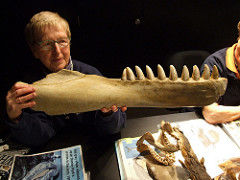
The temporomandibular joint is one of the most unique joints in both man and animal. It is a hinge joint that experiences different sets of movement depending on the species. For example, canines have a TMJ that can move side to side, where felines have a very tight fitting joint that doesn’t allow any lateral movement. Several ligaments cradle the mandible and there are no bony attachments. An articular disc is the main connector between the temporal bone and the mandible, and several ligaments attach here. Depending on where this articular disc falls will determine the anatomy and functionality of the jaw. Since the disc is a separate structure with it’s own set of attachments, it has the capability to move within the joint and actually cause other disorders. Due to its unique nature, the TMJ consists of two joints (one on either side of the head) and it is impossible to produce movement in one without also affecting the other. Within each TMJ joint are two subdivisions, one has blood supply and innervation while the other has none.
One of the biggest problems seen in humans has to do with the articular disc separating and becoming deranged. A similar issue happens in animals, though far less often, and this slippage can lead to a variety of problems, often referred to as TMJ disorders. Symptoms of TMJ disorders include popping of the jaw, inability to open or close the mouth, notable deviation of the jaw, inappetance, pain, and any movement accompanied by crying. What could cause this to happen? Usually, carrying heavy things in the mouth that stress the joint and or trauma leading to a fracture.
Diagnosis can be made based on a thorough history, exam and x-ray. Unless the TMJ disorder is accompanied by osteoarthritis or very clear dislocation, a diagnosis may come back as a non-diagnosis, or completely normal. What fails to be recognized is the motion aspect of the TMJ disorder. If carrying a heavy object stresses the joint, it would be reasonable to suspect repetitive carrying of normal to heavy weighted objects could in fact contribute to a consistent micro trauma to the jaw. If this is the case, the jaw itself could be experiencing a structural shift, or the upper cervical vertebrae could be shifted in which case the jaw would be affected based on biomechanics. Though radiographs and MRI can be helpful in diagnosing disorders, it is also easy to overlook the true cause simply because it isn’t shown on these tools.
Say for instance, an x-ray does reveal osteoarthritis within the TMJ joint. The question therein is what has caused there to be excess bony formation? That is an ongoing process and does not happen overnight, so whatever has lead to the osteoarthritis had to be present for a longer period of time. A structural shift in the normal structure is often a good guess, as the body’s natural reaction to biomechanical changes is compensation through bony formation. If a structural shift is in fact the guilty party, it tends to be quite an easy fix. Adjustments to the jaw and the upper cervical region are gentle, non-invasive, and do not involve any dramatic movements. Improvement is often noted within one to two treatments, and can take approximately 4-6 to make that improvement a more permanent solution. Keep in mind with any animal, the likelihood that they will stop doing whatever it is that lead to the abnormal structure in the first place is small, and that protection is of the utmost importance.
Just ask Miss Mable here, she came to us as a puppy with the inability to hardly open her mouth and a nearly completely locked TMJ. After her first adjustment she let out a HUGE yawn, and after her second her TMJ seemed to be 100% back to normal!
References:
http://www.petmd.com/dog/conditions/musculoskeletal/c_dg_temporomandibular_joint_disorders?page=2#
http://www.mypetsdentist.com/pet-tmj-problems.pml
http://www.ncbi.nlm.nih.gov/pmc/articles/PMC3747040/
https://www.aacfp.org/resources/unique_joint.cfm
Photos Credits:
Lambeosaurus in the Evolving Planet Exhibit at the Field Museum, Chicago, IL via photopin (license)
Orca Mandible via photopin (license)
Camelus via photopin (license)
Didelphis skull via photopin (license)

